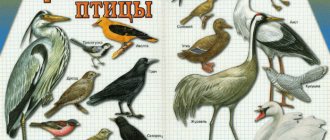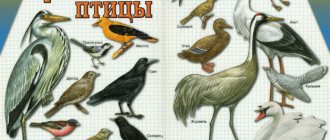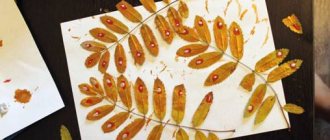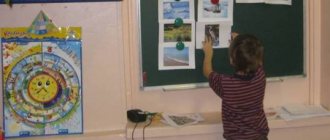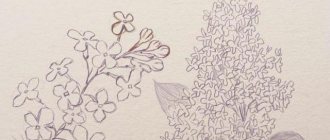Notes on drawing in the senior group “Birds fly south”
Ekaterina Kleeva
Notes on drawing in the senior group “Birds fly south”
SUMMARY OF NODES ON DRAWING IN THE SENIOR GROUP
«BIRDS FLY SOUTH»
ART TEACHER: KLEEVA E. V.
PROGRAM CONTENT: teach children to sketch birds in motion , conveying the basic shape and main parts. Without drawing the details of the plumage . Practice sketching with one pencil or one paint. Consolidate and expand knowledge about wintering and migratory birds . Cultivate a caring attitude towards birds .
MATERIALS: Landscape sheets tinted with blue-violet color (autumn sky, simple pencils, wax crayons; illustrations depicting birds flying south ; reproduction of Stepanov’s painting “The Cranes Are Flying”
.
CONNECTION WITH OTHER EDUCATIONAL AREAS: Watching birds while walking , paying attention to their varied movements
drawing migratory birds outline drawing lessons (senior group)
Drawing lesson notes
Tasks:
Teach children to draw migratory birds, building an image from its component parts.
Develop skills in drawing a sketch of a picture with a simple pencil.
Consolidate and expand knowledge about wintering and migratory birds.
Cultivate a caring attitude towards birds.
Materials:
Recorded bird voices, image of a tree, pictures of wintering and migratory birds, magpie, letter, samples for drawing birds.
Progress of the lesson :
(The voices of birds are recorded. Children with a teacher enter the group)
Educator:
- Let's see what birds are sitting on our tree? Name them. (Woodpecker, tit, crow, magpie, black grouse)
- Oh, guys, I can’t understand something, are all the birds gathered on the tree? Help me to understand. (Children find out that all birds winter and there are no migratory ones.)
- What happened? Where have the migratory birds gone? But here is some letter from the magpie, let’s take the letter from the magpie and read it.
- Oh, children, an accident happened. It turns out that the Snow Queen, the mistress of winter, captured the birds on the way to the south and does not want to release them into the wild. The birds are asking for your help.
“The snow queen is probably bored of being alone and that’s why she doesn’t want to let the birds go.” I suggest drawing portraits of birds and giving them to her. And then she will release all the birds.
- Guys, let's think, why are birds called migratory? That's right, migratory birds are birds that spend half the year with us, and leave us for the second half of the year, flying to other lands. Why do these birds fly away from us in the fall?
-All these birds eat insects. And in the fall the insects disappear. Birds are deprived of their main food and are forced to fly to warmer climes. There are many insects there all year round.
Physical exercise “A flock of birds is flying south”
A flock of birds flies south, the sky is blue all around. (Children wave their arms like wings) In order to fly faster, you need to flap your wings. (Children wave their hands more intensely) The sun is shining in a clear sky, An astronaut is flying in a rocket. (Stretching - arms up) And below the forest, fields - The earth is spread out. (Low bend forward, arms spread to the side)
The birds began to descend
Everyone sits down in the clearing.
They have a long way to go, the birds need to rest. (Children sit in a deep squat and sit for a few seconds) And again it’s time to hit the road. We have a lot of flying to do. (Children stand up and flap their “wings”)
Here comes the south. Hooray! Hooray! It's time for us to land. (Children sit at tables)
- Now look at these pictures. Looking at them, we understand that the body of birds consists of several parts. Which ones? (head, body, tail, wings) What shape is the head? (round) What shape is the body? (oval) What shape is the tail? (can have a triangular shape, or can be forked, like a swallow) The wings have a curved shape if the bird is flying, and oval when folded. The beak is triangular.
— You know how to draw geometric shapes. Therefore, you can easily depict the components of birds. You just need to connect them correctly.
(Show)
-First, let's draw an oval body. Then we will draw the head. Oval wings, slightly pointed at the ends - these are the longest feathers. Rectangular tail, triangular beak, round eyes. And then, let's draw the paws, draw the feathers.
— We take simple pencils and make sketches.
Result:
- Well done boys. You all did your best and we got wonderful birds. I think the snow queen will be pleased and will definitely let our feathered friends go.
— What migratory birds will we wait for?
Game: “Find the migratory bird”
- You all completed the task. I will give you all invitation tickets to the Birds of Migratory quiz.
Source
Summary of the art lesson “Migratory Birds” in the senior group
Olga Lebedeva
Summary of the art lesson “Migratory Birds” in the senior group
Type of activity: direct educational
Age group: senior group
Topic: “Birds of Migratory”
Goal: consolidate methods for conveying bird proportions; develop creative imagination; cultivate a caring attitude towards the environment; consolidate and expand knowledge about wintering and migratory birds. We continue to develop fine motor skills; observe the sequential execution of the drawing; cultivate a love for birds.
Software tasks:
Educational:
- practice drawing birds;
- consolidate the methods of making a sketch with a simple pencil and then painting over it with watercolors;
Educational:
- develop the ability to analyze drawings;
-develop memory, thinking, fine motor skills of the hands, and the ability to enjoy the results of one’s work.
Educational:
— caring attitude towards birds and nature;
- to form in children the desire to complete the work they start.
Methods and techniques:
-Visual: looking at illustrations (paying attention to the characteristics of birds - size, color, leg length, beak shape).
-Verbal: conversation, explanation;
Preliminary work: looking at illustrations of birds, viewing slides “Migratory Birds”.
Material and equipment: pictures of birds; drawing paper, pencil, eraser, watercolor, brushes, water jar, palette.
Progress of educational activities:
Educator: - Let's see what birds are sitting on our tree? Name them. (crow, magpie, woodpecker, tit, black grouse)
- Oh, guys, I can’t understand something, are all the birds gathered on the tree? Help me to understand. (Children find out that all birds winter and there are no migratory ones.)
- What happened? Where have the migratory birds gone? (children's answer)
- Guys, let's think, why are birds called migratory? That's right, migratory birds are birds that come to us in the spring, and in the fall they fly to warmer climes. Why do these birds fly away from us in the fall?
-All these birds eat insects. And in the fall the insects disappear. Birds are deprived of their main food and are forced to fly to warmer climes. There are many insects there all year round. Let's list the migratory birds (swallow, crane, stork, cuckoo, swan, starling, wagtail, duck, lark, heron)
- Please look at all of these and name their similarities and differences. (similarities are the body, head, tail, etc.; differences are the color of the plumage). You and I have already drawn a bird with a pencil. Today we will also draw with paints.
Physical exercise “A flock of birds is flying south”
A flock of birds flies south
The sky is blue all around. (Children flap their arms like wings)
To arrive sooner,
We must flap our wings. (Children wave their hands more intensely)
The sun is shining in the clear sky,
An astronaut flies in a rocket. (Stretching - arms up)
And below are forests and fields -
The ground is spreading. (Low bend forward, arms spread to the side)
The birds began to descend
Everyone sits down in the clearing.
They have a long way to go
The birds need to rest. (Sit down)
And it's time to hit the road again,
We have a lot to fly. (Children stand up and flap their “wings”)
Here comes the south. Hooray! Hooray!
It's time for us to land. (Children sit at tables)
- Now look at these pictures. Let's name what parts does a bird consist of? (head, body, tail, wings)
What shape is the head?
(round)
What shape is the body?
(oval)
What shape is the tail?
(can have a triangular shape, or can be forked, like a swallow)
The wings have a curved shape if the bird is flying, and oval when folded. The beak is triangular.
— You know how to draw geometric shapes. Therefore, you can easily depict the components of birds. You just need to connect them correctly.
Practical part:
-First, let's draw an oval body. Then we will draw the head. Oval wings, slightly pointed at the ends - these are the longest feathers. Rectangular tail, triangular beak, round eyes. And then, let's draw the paws, draw the feathers.
— We take simple pencils and make sketches. (children draw). Then we will paint our bird with paints and create a background.
Result:
- Well done boys. You all did your best and we got wonderful birds.
— What migratory birds do we know?
-Well done guys, you did a very good job today. With each lesson your work gets better and better! Well done!
After class, the work is displayed in a corner along with the original pictures, so that other children can look and compare.
On the topic: methodological developments, presentations and notes
Goal: To make children want to do the work (the image of a fairy-tale bird); encourage them to create a variety of images, using different means of expression (color of plumage, different shapes of beak, tail.
Program tasks: Strengthen the skills of adding and subtracting numbers within 10. Teach children to solve arithmetic problems, put the solution on cards and pronounce notes. Strengthen comparison skills.
Summary of a drawing lesson in the senior group On the topic: “fairy-tale bird” Purpose: To teach children to conceive a fairy-tale image, come up with unusual details for a real image, develop imagination Tasks: ·.
Summary of a lesson on speech development in the senior group.
Learn to sculpt a bird from plasticine using a plastic method, pulling out parts from a whole piece and in a constructive way, observing the location and relationship of body parts, connecting parts, when.
Summary of a drawing lesson in the preparatory group “Migratory Birds”.
Topic: "Chickens". Goal: To introduce children to the technique of palm typing. Learn to add details to an image using a brush. Develop the ability to empathize. Handout
Source
